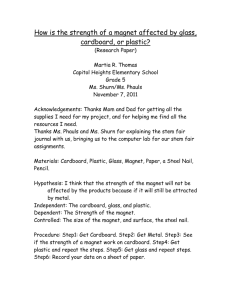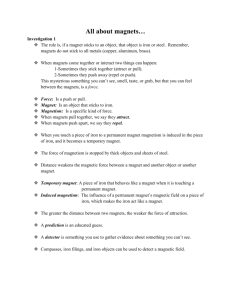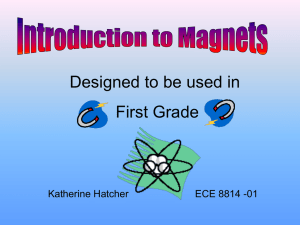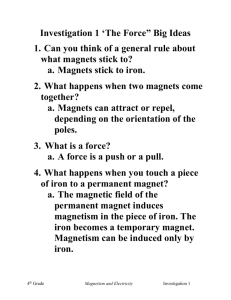Motion and Stability - the Egg Harbor Township School District
advertisement
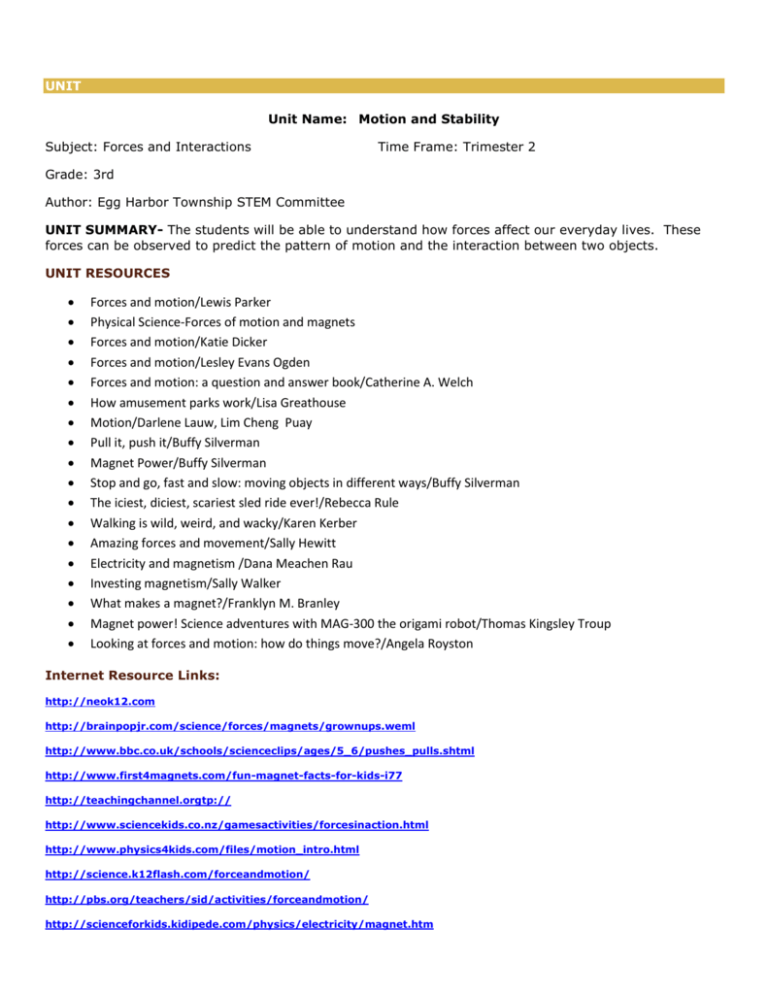
UNIT Unit Name: Motion and Stability Subject: Forces and Interactions Time Frame: Trimester 2 Grade: 3rd Author: Egg Harbor Township STEM Committee UNIT SUMMARY- The students will be able to understand how forces affect our everyday lives. These forces can be observed to predict the pattern of motion and the interaction between two objects. UNIT RESOURCES Forces and motion/Lewis Parker Physical Science-Forces of motion and magnets Forces and motion/Katie Dicker Forces and motion/Lesley Evans Ogden Forces and motion: a question and answer book/Catherine A. Welch How amusement parks work/Lisa Greathouse Motion/Darlene Lauw, Lim Cheng Puay Pull it, push it/Buffy Silverman Magnet Power/Buffy Silverman Stop and go, fast and slow: moving objects in different ways/Buffy Silverman The iciest, diciest, scariest sled ride ever!/Rebecca Rule Walking is wild, weird, and wacky/Karen Kerber Amazing forces and movement/Sally Hewitt Electricity and magnetism /Dana Meachen Rau Investing magnetism/Sally Walker What makes a magnet?/Franklyn M. Branley Magnet power! Science adventures with MAG-300 the origami robot/Thomas Kingsley Troup Looking at forces and motion: how do things move?/Angela Royston Internet Resource Links: http://neok12.com http://brainpopjr.com/science/forces/magnets/grownups.weml http://www.bbc.co.uk/schools/scienceclips/ages/5_6/pushes_pulls.shtml http://www.first4magnets.com/fun-magnet-facts-for-kids-i77 http://teachingchannel.orgtp:// http://www.sciencekids.co.nz/gamesactivities/forcesinaction.html http://www.physics4kids.com/files/motion_intro.html http://science.k12flash.com/forceandmotion/ http://pbs.org/teachers/sid/activities/forceandmotion/ http://scienceforkids.kidipede.com/physics/electricity/magnet.htm STAGE ONE GOALS AND STANDARDS 3-PS2-1: Plan and conduct an investigation to provide evidence of the effects of balanced and unbalanced forces on the motion of an object. [Clarification Statement: Examples could include an unbalanced force on one side of a ball can make it start moving; and, balanced forces pushing on a box from both sides will not produce any motion at all.] [Assessment Boundary: Assessment is limited to one variable at a time: number, size, or direction of forces. Assessment does not include quantitative force size, only qualitative and relative. Assessment is limited to gravity being addressed as a force that pulls objects down.] 3-PS2-2: Make observations and /or measurements of an object’s motion to provide evidence that a pattern can be used to predict future motion. Clarification Statement: Examples of motion with a predictable pattern could include a child swinging in a swing, a ball rolling back and forth in a bowl, and two children on a see-saw.] [Assessment Boundary: Assessment does not include technical terms such as period and frequency.] 3-PS2-3: Ask questions to determine cause and effect relationships of electric or magnetic interactions between two objects not in contact with each other. [Clarification Statement: Examples of an electric force could include the force on hair from an electrically charged balloon and the electrical forces between a charged rod and pieces of paper; examples of a magnetic force could include the force between two permanent magnets, the force between an electromagnet and steel paperclips, and the force exerted by one magnet versus the force exerted by two magnets. Examples of cause and effect relationships could include how the distance between objects affects strength of the force and how the orientation of magnets affects the direction of the magnetic force.] [Assessment Boundary: Assessment is limited to forces produced by objects that can be manipulated by students, and electrical interactions are limited to static electricity.] 3-PS2-4: Define a simple design problem that can be solved by applying scientific ideas about magnets. [Clarification Statement: Examples of problems could include constructing a latch to keep a door shut and creating a device to keep two moving objects from touching each other.] ENDURING UNDERSTANDINGS Investigate unbalanced and balanced forces on the motion of an object. Discover that a pattern can be used to predict future motion. Determine cause and effect relationships of electric or magnetic interaction between two objects not in contact with each other. ESSENTIAL QUESTION KNOWLEDGE AND SKILLS “How do forces affect our everyday lives?” Vocabulary: Attract-to pull something closer Force- a push or a pull Magnet- a piece of metal that attracts other pieces of metal Magnetism-a force that pushes or pulls certain metals Metal-a material, usually hard and shiny, that lets electricity and heat move through it Poles-two opposite parts of something, such as the two ends of a magnet Repel-to push something away Pull-to use force to move something closer Push-to use force to move something away Barrier- a fence or other obstacle that prevents movement or access. The Students will know: A force can change the motion of an object. Forces work in pairs. There are different kinds of forces. Magnetism is a force that may attract or repel certain materials. STAGE TWO PERFORMANCE TASK *Design a swing for your playground using magnetic force to keep the swing moving. o o Materials: String Magnets Pipe cleaners Egg cartons Rubber bands Foil Metal Washers Tape One classroom chair Directions: Students will work in small groups to create a swing that swings as a result of using magnetic force. Each group will use one classroom chair as the base that the swing will be attached to. See attached scenario for the performance task. STAGE THREE LEARNING PLAN Activities, experiences, and lessons: December-February SPARK ACTIVITY: The spark is designed to get students thinking about the unit’s topics and to generate curiosity and discussion. o Materials: Small magnet File folder (to work as thin cardboard) An assortment of magnetic and nonmagnetic items o o o o o Activity: Begin with a magic demonstration. Hold a magnet behind a piece of thin cardboard so students can’t see that a magnet is there. Make a paper clip cling to the side of the cardboard opposite the magnet and in view of the students. Show everyone the paperclip doesn’t fall off, even if you shake the cardboard. Ask students what is holding the paperclip in place Explain that the magnet is holding the paperclip in place. Explain that magnets can hold onto certain things, even through a sheet of cardboard. Allow pairs/groups of students to try the magic themselves. Questions: o What makes the paper clip stick to the magnet, even through the cardboard? o What happened when you tried moving one magnet with another magnet? How was it different from trying to move the paperclip? o Which other object was most attracted to the magnet? o Why didn’t some of the objects stick to the magnet?
